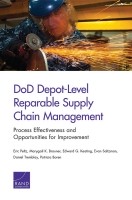| 来源类型 | Research Reports
|
| 规范类型 | 报告
|
| ISBN | 9780833084958
|
| 来源ID | RR-398-OSD
|
| DoD Depot-Level Reparable Supply Chain Management: Process Effectiveness and Opportunities for Improvement |
| Eric Peltz; Marygail K. Brauner; Edward G. Keating; Evan Saltzman; Daniel Tremblay; Patricia Boren
|
| 发表日期 | 2014
|
| 出版年 | 2014
|
| 页码 | 186
|
| 语种 | 英语
|
| 结论 |
Depot-Level Reparables (DLRs) Are Managed Relatively Well by the Services- It is difficult to find DLRs with significant excess inventory due to avoidable situations or poor supply chain management decisions or processes.
- The buildup of excess inventory and resulting disposals stems primarily from DLR phase-outs due to upgrades, reductions in fleet sizes, and complete end item phase-outs, combined with very low condemnation rates.
- However, the data indicate that in most cases of excess leading to disposals, there is a multi-year delay between when DLRs are no longer needed and when disposals occur.
But Some Opportunities for Improving DLR Supply Chain Management Exist- The broadest issue affecting DLR supply chain management effectiveness is parts supportability, with shortfalls degrading customer support.
- The Army's use of a push-like production planning system increases the risk of customer support degradation and the risk of producing serviceable excess when demand shifts.
- Long lead times for contracts affecting DLR supply chain management increase the risk of inventory excess and customer support shortfalls from unplanned changes in demand.
- Service repair planning systems do not always account for all resource lead times and do not account for all anticipatable demand shifts for new and lifetime repair-limited items.
- Having the right metrics in performance-based agreements between the services and the Defense Logistics Agency and using them as a communications tool would help align inter-organizational priorities, driving more-effective execution of collaborative and intra-organizational planning processes.
|
| 摘要 |
- The Department of Defense (DoD) should better explain the item phase-out impact on depot-level reparable (DLR) inventory to improve understanding by external stakeholders and should isolate excess DLR inventory and disposals to make them visible and distinct within overall inventory management performance and disposal reports.
- When items are replaced or end-item fleets are phased out, the plans should include long-term disposal plans for the associated DLRs, and the DLRs should be disposed of more quickly when they and their supported end items are phased out to reduce storage costs and improve perceptions of DoD inventory management.
- The Army should take steps to move toward a more pull-like production paradigm to improve support and reduce the risk of serviceable inventory excess. In general, the services should seek to employ workload planning horizons that minimize total costs to meet customer needs, balancing inventory risk and maintenance productivity.
- When planning depot production parts support, DoD should take a total cost perspective that encompasses supply and maintenance costs. To support this, the services should quantitatively estimate the costs of parts shortages for DLA to incorporate the trade-off between shortage and inventory holding costs in safety stock planning.
- The services and the Defense Logistics Agency (DLA) should build on existing efforts and identify new approaches to further improve DLR supply planning collaboration.
- The Assistant Secretary of Defense for Logistics and Materiel Readiness should establish a base template for performance-based agreements between the services and DLA for depot maintenance support.
|
| 主题 | Maintenance
; Repair
; and Overhaul
; Military Equipment
; Military Logistics
; United States Department of Defense
|
| URL | https://www.rand.org/pubs/research_reports/RR398.html
|
| 来源智库 | RAND Corporation (United States)
|
| 资源类型 | 智库出版物
|
| 条目标识符 | http://119.78.100.153/handle/2XGU8XDN/107683
|
推荐引用方式
GB/T 7714 |
Eric Peltz,Marygail K. Brauner,Edward G. Keating,et al. DoD Depot-Level Reparable Supply Chain Management: Process Effectiveness and Opportunities for Improvement. 2014.
|
|
文件名:
|
x1495315141316.jpg
|
|
格式:
|
JPEG
|

|
文件名:
|
RAND_RR398.pdf
|
|
格式:
|
Adobe PDF
|
除非特别说明,本系统中所有内容都受版权保护,并保留所有权利。